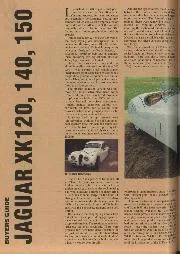
Buyers Guide: Jaguar XK120, 140, 150
Launched in 1948, Jaguar's first postwar sports car the XK120 was an instant success, its beautiful shape and exemplary performance setting new standards which were clearly appreciated on both sides…
” BASIC ” IS BACK
But what are the Prospects for Rallies, Trials and Racing?
RATHER more than a month’s enjoyment of motoring on “basic ” ration petrol will have been experienced by the time these words are read. This new freedom is excellent and the future looks distinctly more rosy from our point of view than has been the case for a long time. We can _expect rallies such as that at Chessington and the London Zoo to happen again, and it should not be impossible to have short trials on saved-up ” basic,” perhaps in August—for officialdom this time encourages the saving up of our pleasure “Pool.” The ration is not sufficiently generous to give rise to hopes of a resumption of the M.C.C. ” Land’s End ” this year, but maybe in 1946 . . .
And how grand will it be to once again make those happy excursions to compete in, marshal, or spectate at, trials. Once more cars will park in convenient places at the foot of slimy gradients and long vigils will be observed 4i,s competing cars attempt the hills. Once again there will be hasty calculations as to whether it will be possible to spectute at another hill on the route before the competitors are due. Gum boots will be dragged off; maps consulted, and cars hastily started and driven across country. . . . After it all there will be gatherings of queerly-garbed men and girls over tea, when motor talk will prevail, interrupted only as the results are read out. We shall realise, when such things happen again, what we have missed these last. five years. But it will not be as it was pre-1989 for many a long day.
For some considerable time trials must, of necessity, be infrequent, and very brief as to route. Racing will take longer to recommence. Donington, Shelsley Walsh and Prescott look like being available fairly soon, but the Crystal Palace may not again see racing on the outskirts of the Metropolis. And the future of Brooklands—mysteriously, excitingly new centre of speed in 1907, surviving the 1914-1$ war to resume in 1920, when .men motored fast with a vengeance, in tricky, spartan cars—the future of Brooklands after this war is, alas, decidedly uncertain. However, we must be thankful for small mercies, and the freedom which ” basic ” provides will be appreciated by none more than the enthusiast.
Carefully-stored sports cars are again coining into use, and all over the country plans are being laid for new “specials ” and changes of car to meet our longpostponed ability to motor where we will, for pleasure. In the excitement and relief of peace, let us not forget those of our world who have fallen in its attainment. The number of racing motorists who laid down their lives has been large. Surely some form of memorial, not necessarily a cold slab of stone, should be founded, that such men shall not be forgotten when cars race again at places where they once raced ? Perhaps an appreciative Government will preserve Brook lands Track for posterity in order that there, where the chequered flag has so often flown, suitable tribute may be made.